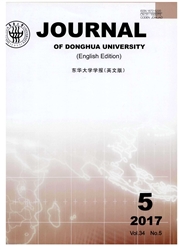

 中文摘要:
中文摘要:
For the purpose of obtaining satisfactory performance of the non-circular gear & crank-rocker & gear trains (NCCRG) weft insertion mechanism which was proposed in this paper, the ideal kinematic curve of this weft insertion mechanism was given, and the reverse solution models of this mechanism were established. A reverse design and simulation software was compiled based on Visual Basic 6.0 to obtain the mechanism parameters, including the pitch curves and tooth profiles of the non-circular gears. A test-bed of this mechanism was developed according to these parameters. The kinematic performance of this weft insertion mechanism was tested by high-speed video tape recorder with its corresponding video analytical software Blaster’s MAS. And the test results were identical with the theoretical calculation. Compared with the conjugate cam weft insertion mechanism which is applied on TT96 rapier loom, under the condition of same weft insertion rate, the variation of acceleration of this mechanism is smaller. This novel weft insertion mechanism can meet the requirements of weft insertion on rapier looms with smooth and steady motion.
 英文摘要:
英文摘要:
For the purpose of obtaining satisfactory performance of the non-circular gear & crank-rocker & gear trains (NCCRG) weft insertion mechanism which was proposed in this paper, the ideal kinematic curve of this weft insertion mechanism was given, and the reverse solution models of this mechanism were established. A reverse design and simulation software was compiled based on Visual Basic 6.0 to obtain the mechanism parameters, including the pitch curves and tooth profiles of the non-circular gears. A test-bed of this mechanism was developed according to these parameters. The kinematic performance of this weft insertion mechanism was tested by high-speed video tape recorder with its corresponding video analytical software Blaster's MAS. And the test results were identical with the theoretical calculation. Compared with the conjugate cam weft insertion mechanism which is applied on TT96 rapier loom, under the condition of same weft insertion rate, the variation of acceleration of this mechanism is smaller. This novel weft insertion mechanism can meet the requirements of weft insertion on rapier looms with smooth and steady motion.
 同期刊论文项目
同期刊论文项目
 同项目期刊论文
同项目期刊论文
 Kinematic analysis of elliptic-gear & eccentric slider-crank & uniform-pitch screw weft-insertion me
Kinematic analysis of elliptic-gear & eccentric slider-crank & uniform-pitch screw weft-insertion me 期刊信息
期刊信息
